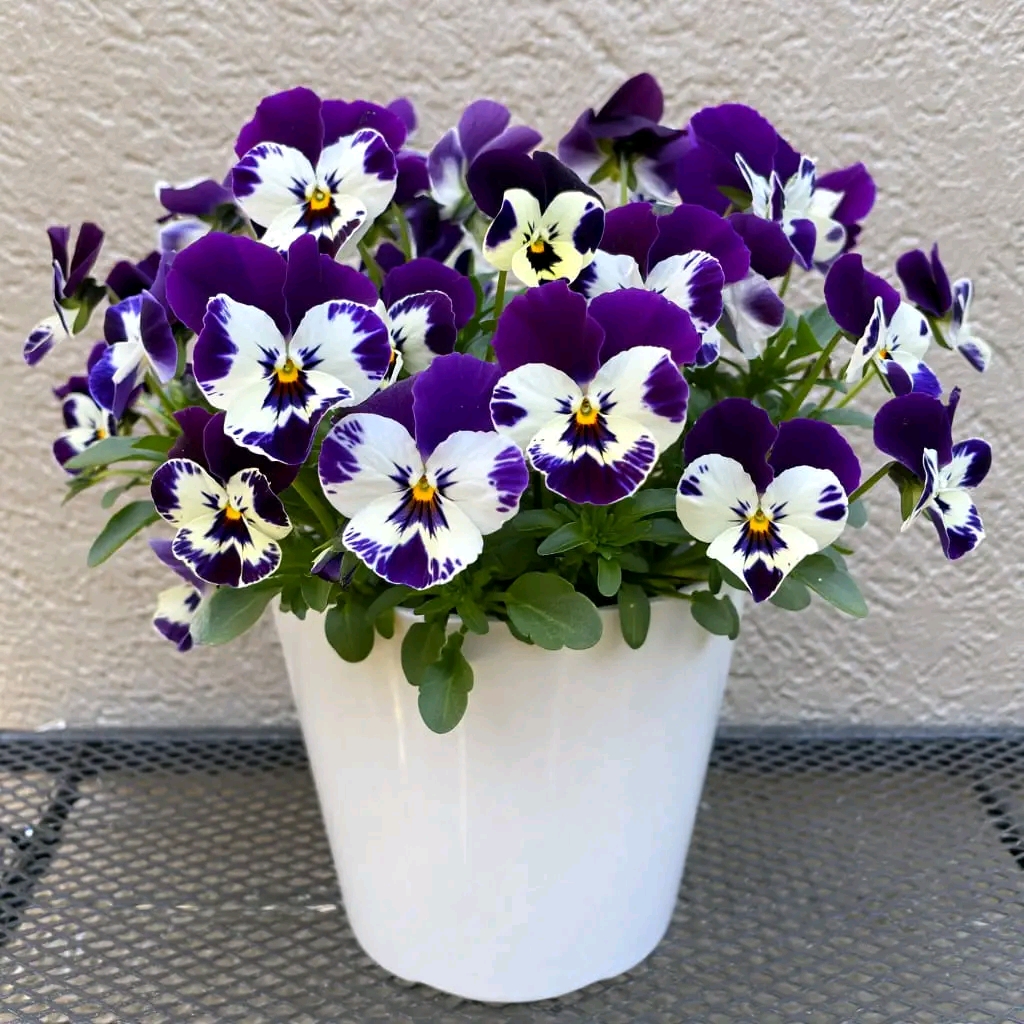Few flowers capture the whimsy and cheer of a garden quite like pansies. With their vibrant colors, playful “faces,” and ability to thrive when other plants are winding down, pansies (Viola tricolor var. hortensis) have earned a loyal following among gardeners for centuries. Whether you plant them in neat rows, scatter them for a wild cottage feel, or let them cascade from a hanging basket, they add an undeniable burst of personality.
The variety pictured here — with its royal purple petals kissed by white and accented with dark violet streaks — is a perfect example of pansies’ elegance. But these beauties are more than just good looks; they’re hardy, adaptable, and surprisingly easy to grow. In this guide, you’ll learn everything from their fascinating history to step-by-step planting instructions, seasonal care, and tips for keeping them blooming longer.
🌿 A Brief History of Pansies
Pansies have a romantic and storied past. They trace their lineage back to the wild viola, a native of Europe and western Asia. In the early 1800s, English gardeners began crossbreeding violas with other wild varieties, creating the larger, more colorful blooms we know today. Their name comes from the French word pensée, meaning “thought” — a nod to the flower’s resemblance to a thoughtful human face tilted downward.
Pansies quickly became a Victorian favorite, symbolizing remembrance and affection. They were often tucked into love letters and given as tokens of admiration. Even now, they carry a timeless charm that makes them perfect for romantic gardens, nostalgic landscapes, and cheerful urban planters.
🌞 Choosing the Right Location
While pansies are adaptable, their performance shines when you meet their basic needs:
Sunlight: In cooler climates, they love full sun — around 6 hours per day. In warmer regions, give them some afternoon shade to protect them from heat stress.
Soil: Loose, fertile, well-draining soil with a slightly acidic to neutral pH (6.0–7.0) is best. Heavy clay soils should be amended with compost or peat moss for better drainage.
Spacing: Plant pansies 6–8 inches apart to allow for airflow and prevent fungal diseases.
🌱 Planting Pansies
When to Plant
Pansies are cool-season plants and can be planted in:
Spring: As soon as the ground is workable and heavy frosts are past.
Fall: About 6–8 weeks before the first expected frost to establish roots before winter.
How to Plant in Beds or Containers
Prepare the soil: Work in 2–3 inches of compost for nutrients.
Dig planting holes: Slightly larger than the root ball.
Set the plant: Keep the crown (where stems meet roots) level with the soil surface.
Water deeply: This helps eliminate air pockets and supports root contact.
Mulch: Apply a thin layer of mulch to retain moisture and regulate soil temperature.
💧 Watering and Feeding
Watering: Keep the soil consistently moist, especially during the first few weeks after planting. Avoid overhead watering late in the day, as wet foliage overnight can promote disease.
Fertilizing: Feed pansies every 2–3 weeks with a balanced, water-soluble fertilizer (10-10-10) or a bloom-boosting formula higher in phosphorus. In containers, more frequent feeding may be needed since nutrients wash out faster.
✂️ Maintenance
Deadheading
Remove spent blooms promptly. This prevents seed formation and keeps the plant focused on producing more flowers.
Pinching
If stems become leggy, pinch them back by one-third to encourage bushier growth.
Pest & Disease Control
Common pests: Aphids, slugs, and snails — handpick, use barriers, or apply organic deterrents.
Fungal issues: Powdery mildew and root rot — improve air circulation, avoid overwatering, and space plants properly.
🌼 Popular Pansy Varieties
Matrix Series — Large blooms in dozens of solid and bi-color patterns; heat-tolerant.
Delta Series — Uniform growth and early blooming; perfect for mass plantings.
Cool Wave® — A trailing pansy ideal for hanging baskets and ground cover.
Swiss Giant — Oversized flowers for dramatic visual impact.
The purple-and-white type in your image is reminiscent of the Delta Premium Pure Violet & White, known for its velvety deep tones and contrasting crisp white petals.
🏡 Seasonal Design Ideas
Spring
Mix pansies with tulips, daffodils, or hyacinths for layered color. They’ll bloom together, creating a stunning cold-weather display.
Fall
Pair pansies with ornamental kale, dusty miller, and chrysanthemums for rich, textured autumn containers.
Winter (Mild Climates)
In zones 7–10, pansies can bloom right through winter, brightening dreary days when most plants are dormant.
🌟 Fun Facts About Pansies
Edible Flowers: Their petals are safe to eat and often used to decorate cakes, salads, and cocktails.
Color-Changing: Temperature affects their pigmentation; cooler temps often make colors richer and more vibrant.
Symbolism: They represent thoughtfulness, remembrance, and free-thinking.
❄️ Overwintering Tips
In regions with mild winters, pansies planted in the fall can bloom again in spring. Protect them with a layer of straw or pine needles before hard freezes, and remove the mulch when temperatures rise.
In colder zones, you can extend their life indoors by moving potted pansies to a bright, cool window where temperatures stay between 40–60°F.
🌺 Why Pansies Deserve a Spot in Every Garden
They’re adaptable: Perfect for beds, borders, window boxes, and containers.
They bloom when others don’t: Bringing color to the garden in early spring and late fall.
They’re affordable: Widely available at nurseries and garden centers.
They’re easy to grow: Great for beginners and children learning to garden.
📋 Quick Care Recap
| Task | Frequency | Tip |
|---|---|---|
| Watering | When soil is dry 1 inch down | Keep evenly moist, avoid soggy roots |
| Fertilizing | Every 2–3 weeks | Use balanced or bloom-boosting fertilizer |
| Deadheading | Weekly | Encourages more blooms |
| Pinching back | As needed | Prevents legginess |
| Pest check | Weekly | Catch aphids, slugs early |
🌸 Final Thoughts
Pansies are more than just pretty petals — they’re resilient, cheerful companions in the garden. Whether you choose rich jewel tones, soft pastels, or the striking purple-and-white blend, they’ll repay your care with months of blooms.
Plant them in cool weather, give them regular attention, and they’ll light up your garden beds, patio containers, and window boxes with their colorful faces. Once you grow them, you’ll see why gardeners around the world have adored pansies for generations.
More Articles You Might Like
-
Texas Toast Sloppy Joes: The Crunchy, Cheesy Upgrade You Didn’t Know You Needed
There’s something timeless about sloppy joes. For generations, this saucy, savory, and slightly sweet ground beef sandwich has been a go-to comfort food in American kitchens. It’s quick, filling, and family-friendly—perfect for busy weeknights. But what if we told you there’s a way to take this classic dish up a notch? Enter the Texas Toast…
-
Classic Pig Pickin’ Cake
When it comes to Southern desserts, few sweets shine as brightly as the Classic Pig Pickin’ Cake. This nostalgic cake, sometimes called a “Mandarin Orange Cake,” has roots deep in Southern tradition. It gets its playful name from its frequent appearance at pig pickin’s—Southern-style barbecue gatherings where communities come together to enjoy slow-cooked pork, sides,…
-
Lemon Garlic Butter Chicken with Creamy Parmesan Pasta
There’s something irresistible about the combination of tender, golden-browned chicken paired with a creamy pasta coated in Parmesan cheese. Add the brightness of lemon, the depth of garlic, and the richness of butter, and you have a recipe that feels indulgent yet approachable enough for a weeknight dinner. Lemon Garlic Butter Chicken with Creamy Parmesan…



